Saint of the Day – 9 December – St Peter Fourier C.R.S.A. (1565-1640) Priest, Founder, Reformer, Confessor, Theologian, Teacher, Preacher, Apostle of Prayer, Penance and Charity, Marian devotee – “the Good Father of Mattaincourt” “le bon pere de Mattaincourt” – born Pierre Fourier and died on 9 December 1640 at Gray, Haute-Saone (modern France) of natural causes.
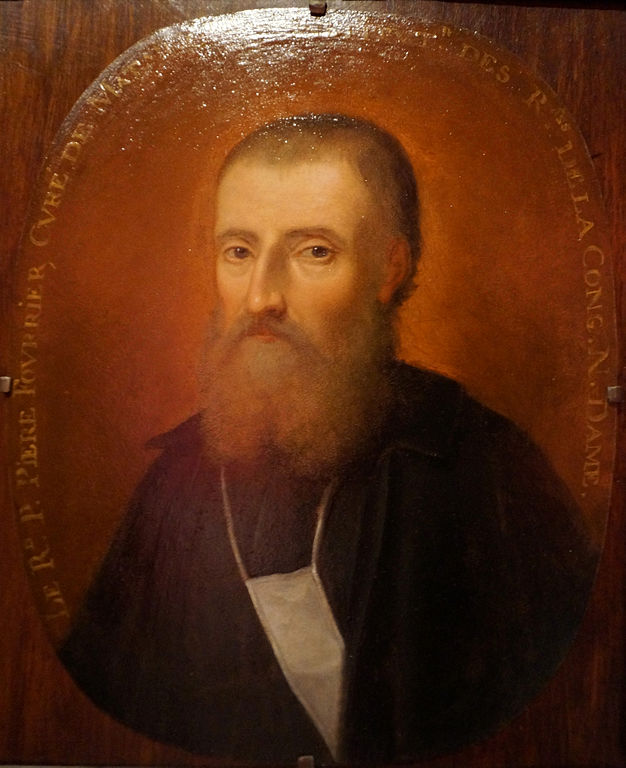
Peter Fourier was born at Mirecourt, Lorraine, on 30 November 1565. At fifteen he was sent to the University of Pont-à-Mousson. His piety and learning led many noble families to ask him to educate their sons. He became a Canon Regular in the Abbey of Chaumousey and was ordained in 1589. By order of his abbot he returned to the university and became proficient in patristic theolog – he knew the “Summa Theologica” of St Thomas by heart.
Before saying his first Mass he passed several months of retreat in the exercises of prayer, penance and tears. He was then sent to complete his theological studies at the university of Pont-au-Mousson, also in Lorraine. There Father Jean Fourier, a relative who was Rector of that University, directed him admirably. His progress in virtue and the sacred sciences placed him high in the opinion of the Cardinal of Lorraine and Bishop of Metz, who desired to have him in his diocese; he offered him a parish where his talents would bring him advancement. But the young priest, wishing to flee all honours, declined, to return to his Abbey.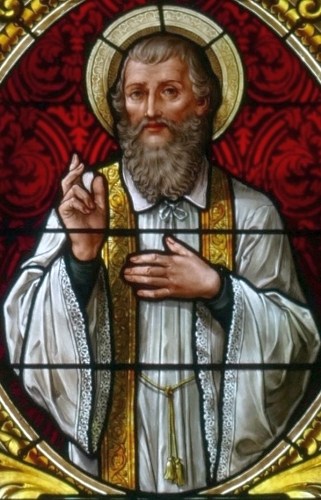
After his return to his canonical community, however, he was subjected to two years of hostility and abuse by his fellow canons, even by some accounts a case of attempted poisoning. He chose not to confront his abbot with the situation and accepted this persecution patiently. The care of local parishes in that region of France was routinely entrusted to the many abbeys and priories of canons. In 1597, when his abbot was assigning him a post, Fourier passed over two prestigious options and accepted the post of vicar of the parish of Mattaincourt in order to combat the indifference to religion widespread in the town, and to counter nascent Calvinism in the area. He went on to spend the next twenty years of his life serving its people.
To this end, Fourier instituted two major reforms that showed his intelligence and concern for his flock. The first of these was to improve the financial lives of his community by setting up a community bank, from which the townspeople could borrow without interest. His motto in serving the parish was ‘to feed only one person, was to to be of use to all.’ His second innovation was in his preaching style, where he employed dialogues with small groups of his parishioners to explain better their Catholic faith to them. He had his pupils engage in dialectics on Sundays on the various virtues and vices in practice by the congregation. This style proved immensely successful.
Fourier led an extremely ascetic way of life while serving the people of his parish. He would spend much of the night in prayer. He refused the services of a housekeeper, even when his own stepmother offered to provide his care. His severe self-denial enabled him to direct much of the income of the parish to the needy of the town. He himself would often spend the night nursing the sick of the town.
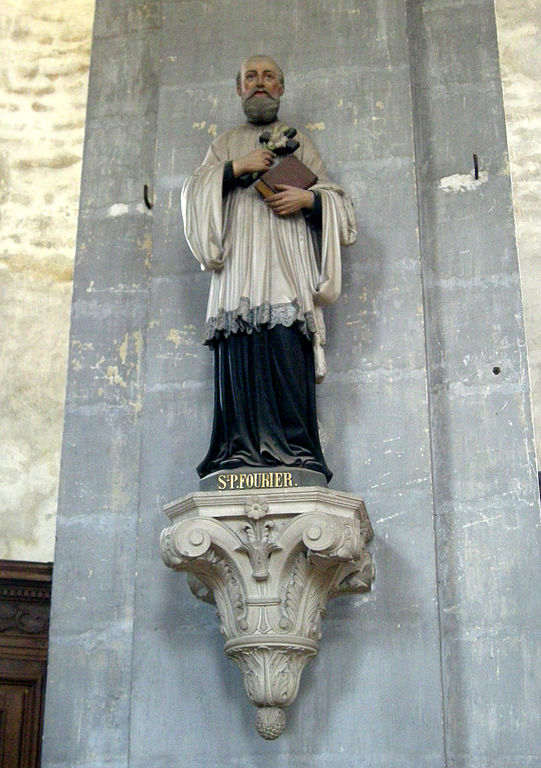
The success of Fourier’s pastorate in inspiring his flock to a greater fidelity to the faith was brought to the attention of the local bishops of the region. They prevailed upon him to go about to different parishes to preach to the people. He did so and, as a result of seeing the situation of the populace throughout the region, he was struck by the depths of their ignorance and superstition.
Together with the Blessed Alix Le Clerc, in 1597, Fourier founded the Congregation of Notre Dame of Canonesses Regular of St Augustine, who were committed to the free education of children, taking a fourth vow to that goal. Soon there were six schools run by his spiritual daughters. He played an active role in their education, being credited with the invention of the blackboard and its use in the classroom, as well as the division of students into classes of a similar level of instruction. By the time of his death, the number of schools run by the canonesses had grown to forty. They went on to spread throughout France, Germany and England.
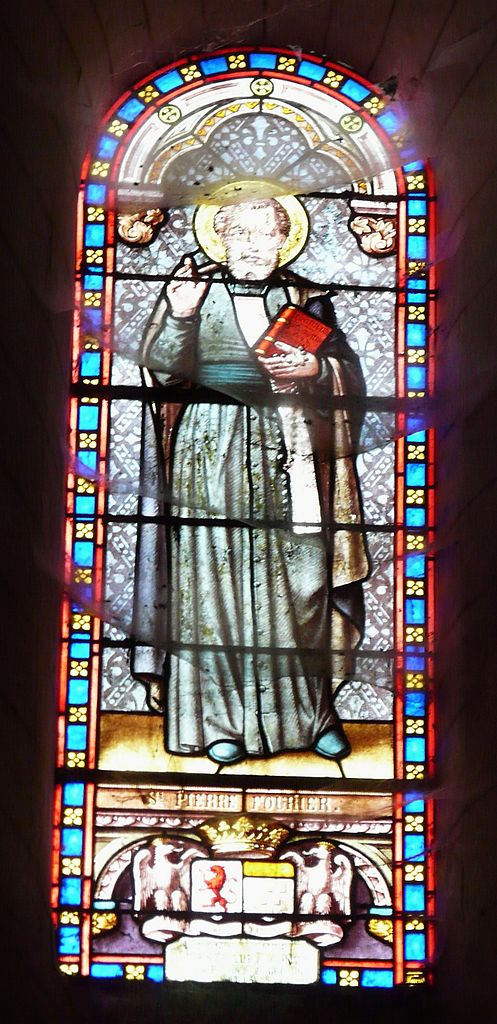
Church of Saint Martin, Coulaures, Dordogne, France
Fourier’s vision also extended to the life of his own Order. He sought to revive a spirit of fervour and discipline in the communities of the canons regular. In 1621 the Bishop of Toul, Jean des Porcellets, chose him to organise the canonical communities in his diocese. He, therefore, entrusted the ancient Abbey of St Remy in that city to Fourier and six companions, where they could lead the way of life he envisioned. Within four years, eight houses of the Order had embraced his reform. In 1625 they were formed into a new congregation of all the priories of canons in the duchy. To reinforce the reform, any canons who wished to join had to undergo a new novitiate and profession of vows. Otherwise they could retire with a pension from the canonical life. On 11 February 1628 they were officially named the Congregation of Our Saviour by the Holy See.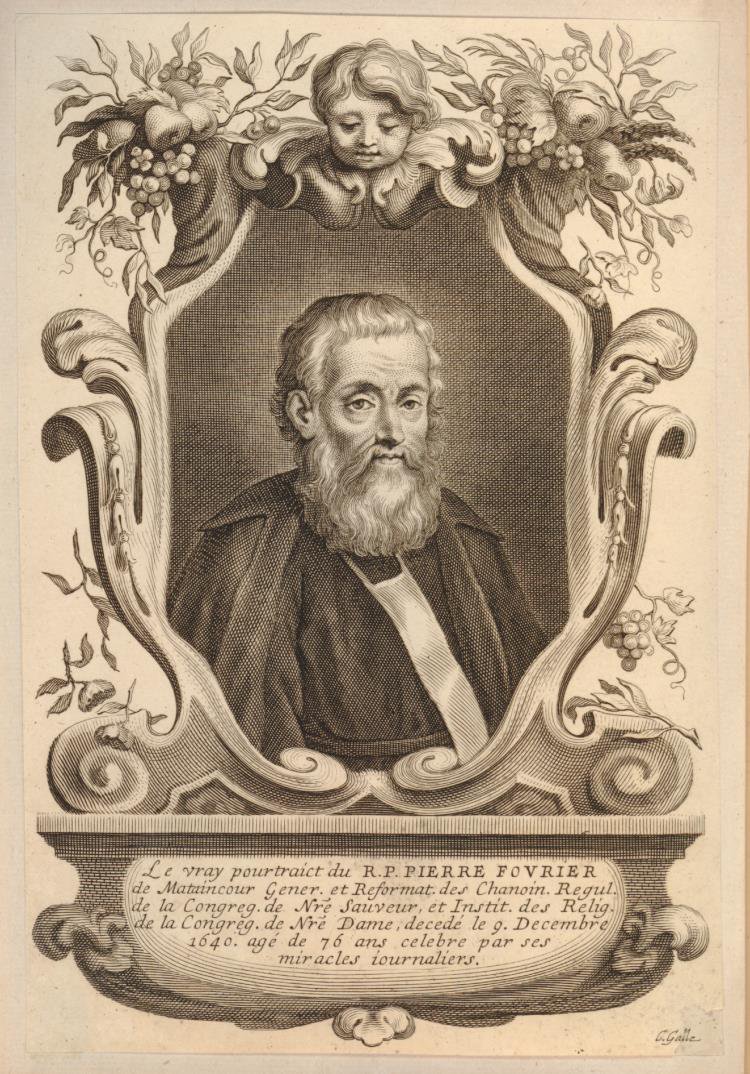
The method of reform established by Fourier served as a model for the reform of the canons regular in the Kingdom of France, where, with the support of Cardinal Rochefoucauld, the Congregation of France was established with these same conditions. In 1625, Fourier was charged with preaching to the people of the Principality of Salm-Salm, which had embraced Calvinism. Within six months his gentle persuasion and efforts were rewarded with the re-establishment of Catholicism in the realm.
Fourier himself was elected as Abbot General of the congregation in 1632. He hoped to guide his fellow canons to caring for children, as the canonesses were doing. This vision never took root among the men, however.
After the invasion by the Kingdom of France of the Duchy of Lorraine in 1632 under Cardinal Richelieu, Fourier refused to swear an oath of loyalty to King Louis XIII of France. Thus he and his community were forced to flee their monastery in 1636, taking refuge in the town of Gray in the neighbouring County of Burgundy. Fourier and the canons with him were occupied in that city nursing plague victims. It was there that he died on 9 December 1640.
His spiritual sons, his spiritual daughters, the good people of Gray in Bourgogne, who had welcomed him and whom he had served admirably during an epidemic of the pestilence, all wanted the honour of possessing his mortal remains. But so did also the parish of Mattaincourt. To the reformed Order of Saint Augustine this privilege was granted officially but the pious women of Mattaincourt, blocking the church door, would not permit the Canons to resume their journey with the coffin, after they had stopped in his former parish for a day or so. His heart had already been left to the parish of Gray.
St Peter spread everywhere devotion to the Immaculate Conception of the Blessed Virgin. More than two centuries before the Miraculous Medal in 1830 and the proclamation of the dogma in 1854, he saw to the distribution of large quantities of a medal he had struck, on which were engraved the words – “Mary was conceived without sin.”
Miracles abounded at his tomb, as they did during his lifetime, by his prayers. He was Beatified by Pope Benedict XIII in 1730 and Canonised by Pope Leo XIII in 1897. St Peter Fourier is honoured by a statue of him in St Peter’s Basilica among the founders of religious orders.
The vision of Fourier was exported to Canada in 1654 by St Marguerite Bourgeoys CND (1620-1700), who was the president of a sodality of volunteers associated with the work of the cloistered canonesses. Moving to New France at the invitation of its governor, she became one of the early founders of the new colony. There she established the Congregation of Notre Dame of Montreal, which was the first to provide education to the children of the colonists, as well as to the Native American children. Her work has been highly successful both there and in the United States of America.



5 thoughts on “Saint of the Day – 9 December – St Peter Fourier C.R.S.A. (1565-1640)”